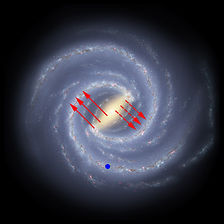
GalaxyBy Simon Kneen
Galaxy
Patterns in Star Orbits Reveal the Origin and Evolution of Galaxies and Generate Vast Grand Designs.
Patterns of Star Orbit.
The movement of matter in galaxies is controlled or orchestrated by powerful processes that dominate galaxy evolution and produce features of morphology. We take a closer look at these patterns which show how galaxies and the stars in them, evolve.

True: Galaxies are beautiful and symmetrical. Patterns of symmetry relate to the centre. The galaxy rotates around the SMBH central object like a wheel around that axis.
Symmetrical galaxies show rotation around and connections to central object. Credit: A. Barth (UCI), ALMA (NRAO/ESO/NAOJ); NASA/ESA Hubble; Carnegie-Irvine Galaxy Survey.

Interpretation by design: Outward spiralling would generate symmetrical and circular galaxies with the SMBH as the axis, as outflow that forges these features, spreads out in all directions from this centre.

Perfectly uniform pattern of rotation as gradual slowing from the centre. Image credit: N. Scoville (Caltech), T. Rector (U. Alaska, NOAO) et al., Hubble Heritage Team, NASA. M51: The Whirlpool Galaxy
Stars seem to rotate around the galaxy core in sedentary system of unified direction, speed and near circular orbit.
Outflow would create a sedentary system that will generate orbits of the same speed and direction forming uniform, gradually spiralling (therefore slowing) trajectories, as demonstrated in patterns of stellar orbits around galaxies centre. Disruptive and random merger has massive problems to reconfigure this sedentary pattern of orbit from that chaotic union process.
Read more on the connection between motion of stars in galaxies and formation of the Spiral Arms.
%20(1).jpg)
Star rich centre with gradual declines in star light density to outer edge. Image credit: NASA. The Andromeda Galaxy (M31)
Patterns in density of star light (and therefore, density of stars) increase steadily across the Galaxy, towards the centre, were stars are tightly packed in the active core.
Outflow produces an active galaxy centre as the major star forming region in the galaxy and describes why its densely packed with stars. Spiralling away from the middle will form a constant decline in density of stars from the centre out. The same pattern of star density is found in other, probably associated, structures like dwarf galaxies.

Andromeda galaxy showing powerful star forming (hot, new, blue stars are young) at the centre. This star forming is predicted by outflow but is not well explained in merger.
More at: Milky Way may have formed 'inside-out': Gaia provides new insight into Galactic evolution. Jan. 19. 2014 Phys Org.
NASA, ESA, and A. Feild (STScI)

IC342. The 158-micron spectral line is ionized carbon, and indicates the presence of a cold, dense gas cloud (the ideal requirements needed for star formation), or it can indicate a hot gas cloud irradiated by young stars. Image credit: Röllig et al.
%20(2)%20(1)%20(1).jpg)
Galaxies form a vast flat disc. This Galactic Plane rotates around the central SMBH's 'equator' as the axis of that 'object' and the axis of the Galaxy are the same.
The Galactic plane is related to the equator of the SMBH because that is where outflow originates. In outflow, stars form and escape (how is explained latter) the centre continue an outward trajectory forging a vast disc.
Vast disc of the Galactic Plane rotates around central objects 'equator'. Image credit: NASA. The Sombrero Galaxy

Artist's illustration of the outflow disk and jets surrounding a super massive black hole 'released' from around the 'equator'. Credit: Cosmovision, Dr. Wolfgang Steffen.

The Bar of stars passes straight across the galaxy centre through the general location of the central SMBH showing a strong connection in evolution.
The Bar of stars suggests outflow from the central object is focused in two places as jet type structures (see Outflow page) and part of matters outward travel. Stars in the Bar are moving away from the centre in outward trajectory.

The Bar of Stars have outward spiraling momentum.
Massive 'Bar' of stars connects through galaxy centre. Image credit: ESA / ATG medialab. Barred Spiral NGC 1300
Credit: Jordan Raddick (Johns Hopkins University) and Gail Zasowski (The Ohio State University / University of Virginia). Artist's concept by NASA/JPL-Caltech/R. Hurt (SSC-Caltech).

The Spiral Arms connect to the Bar of stars at or near the outer edge of the central region called the Bulge.
The outflow process seems to have two jet like structures out of the centre called the Bar. These 'jets' continue across the galaxy, in outflow, as a vast spiral. Generally, stars found toward the Galaxy Centre are short lived (live hard, die young), while stars found far out are long lived types - as predicted by outward progression.

Strong connection between mass of galaxy and mass of central SMBH.
A close correlation between the mass of the galaxy and central object may show a causality as if they 'grow' or evolve together. The origin of outflow could provide a way to increase the mass of both (covered later) at the same time. Merger cannot explain their correlation in mass.
Illustrasion: NASA/STScI